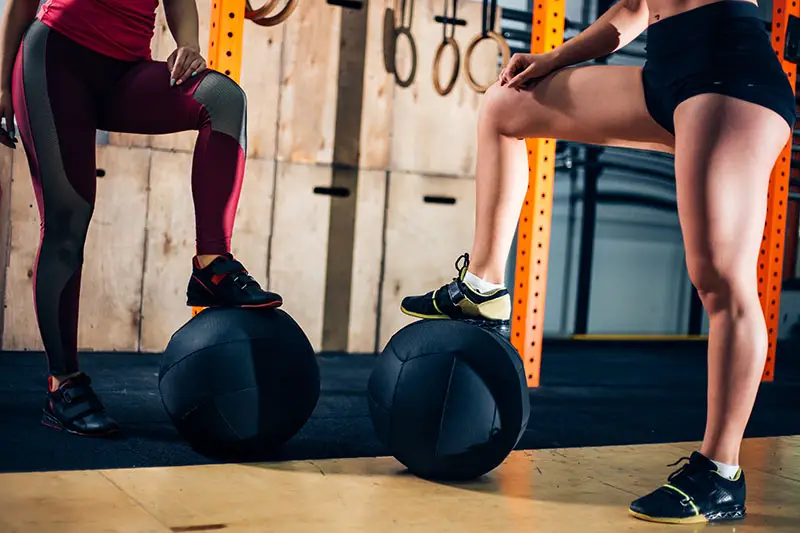Ball Taps
Want a versatile workout that checks all the boxes? Look no further! You can incorporate ball taps into your workout regime to help achieve a variety of fitness goals. If you haven’t started doing ball taps, use this article as a guide and get started now!
You may wonder what, exactly, are ball taps? Well, you may have heard of a toe tap before, and ball taps are very similar in execution! They are mostly the same movements – continuously alternating which foot taps an edge as quick as you can go. The only difference is that you are using a medicine ball on the floor instead of a stationary surface, like a step or a ledge of some sort.
Contents
As said before, this is a very versatile exercise, so it’s hard to figure out what category it goes in. It builds muscle, but it’s not necessarily a strength building exercise. It gets your heart rate pumping, but it’s not completely regarded as a cardio workout. When done in longer spurts, it definitely promotes muscle endurance, but, again, it’s not specifically labeled as such. So, we like to think of ball taps as all the above. Some even use it as a warmup before their strength training workout or cardio session! It can do it all!
Before we dive into the benefits and walk you through doing ball taps, it’s important to note that, like the toe tap, we consider ball taps an intermediate level exercise. Of course, there are modifications that you can make to help work your way up to successfully completing this type of exercise. But because of the balance and quick pace required, you will need a little more experience to execute them properly!
Benefits of Ball Taps

Where do we even begin? Ball taps have a long list of benefits!
To start, they are targeting a variety of muscles in your lower body, including quads, hamstrings, calves, and more. So, you’ll see improved strength in these areas, but because you are tensing your body in an almost jumping motion, you’ll also be using upper body muscles as well – especially your core!
On top of this, because you do them with speed over 15 to 60 second bursts, it’s great for your muscle and physical endurance. Not only will your endurance improve by doing ball taps within your workouts, you’ll also reap the long-term benefits of doing cardio-based exercises. These benefits include improved heart strength, reduced risk of heart disease, and other cardiovascular benefits.
This could probably go without saying, but we also have to mention the more obvious health benefits of doing a high impact, fast-paced exercise. For example, since this will get your heart rate pumping, you’re going to be burning more calories in a short amount of time! This means that ball taps will help you burn more fat while you tone your lower body muscles and your core!
How To Do Ball Taps
Now that we know all the amazing reasons we should start doing more ball taps, let’s break it down step-by-step so we know the proper form and techniques!
Like I said earlier, ball taps are very similar to toe taps with one distinct difference: a medicine ball. To start this exercise, you need to have a medicine ball on the ground in front of you. Ideally, you want a medicine ball that is heavy enough to remain stationary, around 10-20 pounds, and that is at least 6 inches tall.
No products found.
Step 1. Begin standing in front of your medicine ball with your hips and shoulders square to the ball. Your arms should be by your side or in an athletic stance.
Step 2. Raise one leg, placing the ball of that foot on the ball while your other foot remains solid on the ground.
Step 3. With your opposite foot, quickly push off the ground as you alternate in the air which foot is on the ball and which foot is on the ground.
Step 4. Continue alternating which foot is tapping the medicine ball. Start slowly to gain confidence, but as your confidence builds, continue to build your speed. Be sure to keep your abs and core tight as you continue this exercise until your determined amount of time is up.
Ball Tap Variations and Modifications

As mentioned earlier, we traditionally regard this exercise as intermediate, but there are variations and modifications you can make to be both easier and more challenging. Here are just a few of our suggestions…
Pace
While it is designed to be a fast-paced exercise, you can always change the pace to align more with your skill set and fitness level. If you are new to this exercise, new to working out, or working your strength back up from an injury, you can start slower and work your way up.
Likewise, if you notice that you have been doing this exercise without getting winded or sweating, try to challenge yourself to alternate taps more quickly! You could challenge yourself to get a certain amount of taps in by a designated amount of time!
Intervals
Just with pace, you can also build up the time you do this exercise to help meet your fitness needs and goals! You could always start out by doing ball taps in 10-15 second intervals with longer rest breaks in between. As you become more comfortable, you can increase the time you’re doing ball taps and decrease your rest. Most fitness experts suggest doing ball taps for 30-60 second intervals.
Type of Ball
Using a medicine ball for ball taps requires a great deal of core strength and stability. Because medicine balls can move, you’ve got to stay focused on its location in order to not get tripped up or fall. If you want something with a little more stability, but has the same effect, you could always try a bosu ball! It will stay put on the ground more easily while also having enough give to challenge your core.
No products found.
Platform
If you are just beginning with ball taps and want a very stable alternative or you simply don’t have a medicine ball handy, then you can always use an aerobic step bench, a plyo box, or simply use a step in your home or in your gym! As I said above, toe taps have very similar benefits and are a great place to start!
Common Ball Taps Mistakes
Engagement
If you want to reap all the amazing benefits that ball taps offer, you’ve got to keep your core engaged throughout your workout! It’s one of the biggest mistakes people make when doing this exercise. It’s easy to forget about, and it makes the workout less intense! Keep your core tight and you’ll get more benefits in less amount of time!
Posture
Yes, you want to look down and see the medicine ball below, but you have got to make sure that you keep your posture straight. A lot of times, people will accidentally hunch over as they become tired. This will not only hinder your overall benefits, but can also increase your chances of injury! So, don’t forget to keep your shoulders square and your back straight!
Being Aware
Lastly, medicine balls aren’t stationary. While they won’t roll all the way across the floor, they will move a little. As you are doing ball taps, be sure to keep your posture straight, but continue to keep your eyes down, seeing where your foot is landing each time. As you grow more tired, stay aware in order to prevent tripping up and potentially getting injured.
Safety When Doing Ball Taps
As stated above, it’s important to be safe when doing ball taps because the medicine ball can move.
If you are recovering from or have a history of any injuries that could inhibit the movements listed in our how to section, be sure to always consult a doctor before attempting! While we generally regard this as a safe exercise, it’s always important to consider your own health and fitness level and, when necessary, consult a physician in order to work out safely and achieve your fitness goals!

